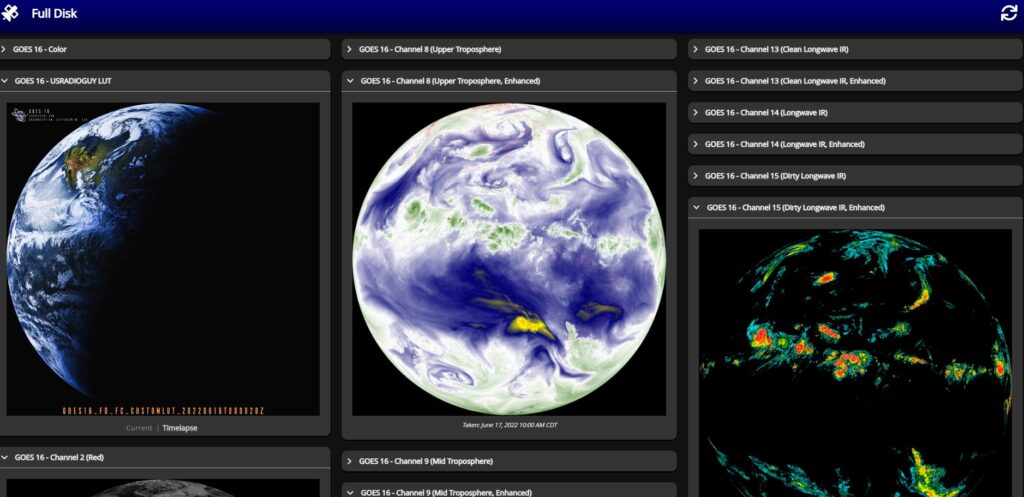![]()
Vitality GOES- A new tool to work with imagery and data created by goestools and/or Satdump
Jamie Vital has built a Web App for showcasing Geostationary Weather Satellite Data. The software is designed to display text and images received from GOES satellites via goestools and satdump.
UPDATE: 1/27/2023
The author of Vitality GOES just pushed a new version of Vitality GOES – 1.4 with several new features! The update has something for many of us, no matter where in the world we are.


What’s new in Vitality GOES 1.4
- The image categories in the main menu are now customizable. Instead of being stuck with “Full Disk”, “Level 2 Imagery”, “EMWIN Imagery”, and “Mesoscale Imagery”, you can now change the name, icon, and contents of all these pages – and add your own categories!
- On GOES-16/18, NWS Images are now viewable – this was completely missing before
- On GOES-16/18, the “Level 2 Imagery” has been renamed to “Non-CMIP Imagery” by default
- Added some missing EMWIN imagery into the sample emwin.ini config files
- Reduced network overhead for a (slightly) more responsive experience
- Improved error handling – most errors will now display on the screen instead of making the program lock up at “Loading, Please Wait…”
- Added a config file for EWS-G1 (GOES-13) GVAR
- Added a config file for GK-2A LRIT
- Other bug fixes
You can get the newest version from https://github.com/JVital2013/vitality-goes. Note this version requires updating your config files as well At least the change gives you more flexibility and the ability to support more satellites.
SatDump is supported for Windows/Linux! This makes it so you can run the entire stack (SDR -> SatDump -> Vitality GOES) all on one Windows Host, which could be helpful for some folks. Jamie put together a video at https://www.youtube.com/watch?v=XMDAiUjzkhw that goes over how to throw together a setup that can be evolved into a full, Windows-based ground station. I think one of the great features of this app is the ability to sort and make useful the thousands of EMWIN images, text, forecasts, radar, etc. that can be received.
One newer feature is an “Alert” that appears at the top of the local weather page that lets the user know if there are any warnings/watches or other weather emergencies.
Jamie Vital has built a Web App for showcasing Geostationary Weather Satellite Data. The software is designed to display text and images received from GOES satellites via goestools.
The author has written a great description of the software package he created and has it over on his github page which you can find here: https://github.com/JVital2013/vitality-goes
What does Vitality GOES do?
Vitality GOES makes data from the GOES HRIT/EMWIN feed easily accessible, through a web browser, from anywhere on your local network. Even if the internet goes down, people on your local LAN can still access real-time weather information.
Vitality GOES has the following features:
- Once set up by the ground station technician (you!), Vitality GOES is easily usable by anyone with no knowledge of radio, satellites, or programming.
- It presents all full-disk, Level 2 products, and mesoscale imagery in a user-friendly and easily navigatable way.
- Pertinent EMWIN data (which includes current weather conditions, forecasts, watches, and warnings) are presented to the user in a way that is appealing and easy to read. There is no need to parse through data for other locations: your configured location’s data is the only thing you’re shown. For a write-up on the EMWIN data Vitality GOES pulls and how it’s used, see here.
- It is able to monitor the status of the underlying goestools stack, including systems temps, error correction rates, and packet drop rates.
How does it work?
The following diagram shows how data flows from a GOES satellite, through Vitality GOES, and to the end-users:

To put it simply: goestools and secondary scripts dump data to a folder on the ground station computer. From there, Vitality GOES reads the data and presents it to the user on their device across the local network.
A few examples running on my system while I was testing it.




Added the ability to display my composite Meteor Imagery

And the ability to display GOES 16, 17, and 18 (18 is from last weeks interleave tests)

The software is highly configurable and with some tweaks to the css, script, you can really customize this to your own preferences as I did, shown below:








